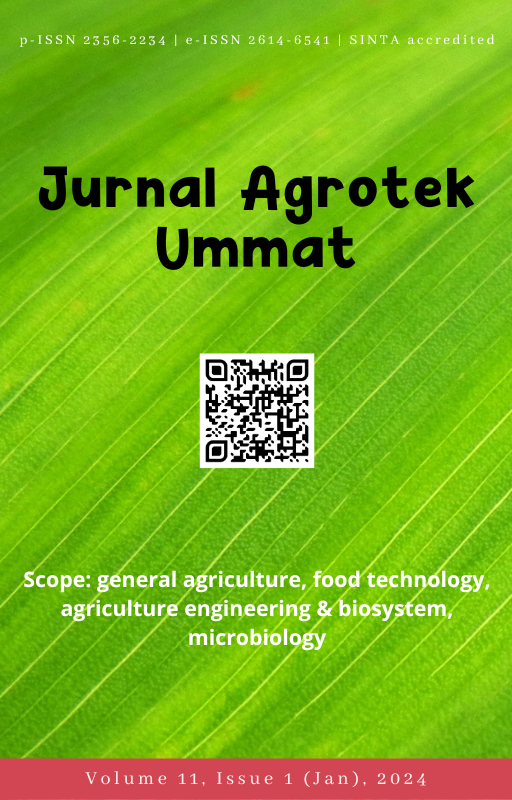Development of data acquisition biogas monitoring system based on IoT
DOI:
https://doi.org/10.31764/jau.v11i1.20574Keywords:
biogas, cayenne, internet of things, monitoring, pressureAbstract
The development of microcontroller and semiconductor technology continues to increase in line with demands for system control and monitoring, including in the context of renewable energy. This control and monitoring process is also applied in biogas production. Conventional biogas plants in the field are not monitored so that communities face various challenges including a lack of organic material (low organic loading rate) and overload (excessive organic loading rate). Overloading slows or stops the anaerobic digestion process and can cause total system damage. Furthermore, another challenge that arises from inadequate or nonexistent monitoring of biogas plants is poor production due to excessive temperature fluctuations or inappropriate temperature ranges for various types of methanogenic bacteria. this research introduces an innovative monitoring system capable of accurately tracking several key parameters, including air temperature and humidity (DHT22), organic material temperature (DS18B20), and biogas pressure (MPX5700DP). This solution is built on the Internet of Things (IoT) concept, utilizing Arduino as the sensor data processor and Wemos D1 Mini as the wifi module connecting the system to the IoT platform, Cayenne. These findings provide valuable insights into the performance of the biogas installation during that specific time period. With the implementation of this monitoring system, it is anticipated that the efficiency and stability of biogas production can be improved through accurate and real-time monitoring of key variables in the biogas production process. Analysis of monitoring data reveals that the highest air temperature generally occurs during the daytime, particularly between 13:00 and 14:00, while the lowest air temperature is recorded in the morning around 05:00 to 06:00 on rainless days. Additionally, organic material temperature exhibits fluctuations, with the lowest point typically occurring between 06:00 and 09:00, and the highest point between 15:00 and 20:00. Biogas pressure reaches its peak on the sixth day, namely on January 10, 2022, at around 13:00, with pressure reaching 3.9 kPa.References
Daniyan, I. A., Daniyan, O. L., Abiona, O. H., & Mpofu, K. (2019). Development and optimization of a smart system for the production of biogas using poultry and pig dung. Procedia Manufacturing, 35, 1190–1195. https://doi.org/10.1016/j.promfg.2019.06.076
Febrian, A. (2015). Analisis Kelayakan Finansial Instalasi Biogas Dalam Pengolahan Limbah Ternak Sapi Di Kabupaten Lombok Tengah. 1(2), 1–13.
Haryanto, A., Okfrianas, R., & Rahmawati, W. (2019). Pengaruh Komposisi Subtrat dari Campuran Kotoran Sapi dan Rumput Gajah (Pennisetum purpureum) terhadap Produktivitas Biogas pada Digester Semi Kontinu. Jurnal Rekayasa Proses, 13(1), 47. https://doi.org/10.22146/jrekpros.41125
Hidayat, M. R. (2019). Rancang Bangun Outflow Valve System sebagai Proteksi Over Pressure Dengan Menggunakan sensor MPX5700DP pada Miniatur pesawat CRJ 1000. In Politeknik Negeri Sriwijaya Palembang (Vol. 8, Issue 5).
Manyuci, M. M., BOBO, A. E., IKHU-OMOREGBE, D. I. O., OYEKOLA, O. O., & others. (2016). Biogas Production from Saw dust using Acti-zyme as Digestion Catalyst and its Upgrading to Bio methane using Chemical Absorption. October.
Marbun, T. K. (2018). Co-digestion sampah pasar dan feses sapi untuk meningkatkan produksi biogas.
Mujdalipah, S., Dohong, S., Suryani, A., & Fitria, A. (2014). Pengaruh Waktu Fermentasi Terhadap Produksi Biogas Menggunakan Digester Dua Tahap pada Berbagai Konsentrasi Palm Oil-Mill Effluent dan Lumpur Aktif. Agritech, 34(1), 56–64.
Mulyati, M. (2009). Desain Alat Biogas Dari Kotoran Sapi Skala Rumah Tangga. Jurnal Teknik Industri, 9 (1), 1–16.
Mulyati, M. (2015). Desain Reaktor Biogas Dari Eceng Gondok Skala Rumah Tangga. Seminar Nasional Nasional Teknik Industri SEMNASTI-MUSINDEEP, November, 230–238.
Putri, A., & Gumay, Marliza Ganefi, N. S. S. (2018). Sistem Pemantau Suhu dan Tekanan Biogas pada Biodigester Berbasiskan Android. Atmaluhur, 8–9.
Razmi, D., Lu, T., Papari, B., Akbari, E., Fathi, G., & Ghadamyari, M. (2023). An Overview on Power Quality Issues and Control Strategies for Distribution Networks With the Presence of Distributed Generation Resources. IEEE Access, 11(February), 10308–10325. https://doi.org/10.1109/ACCESS.2023.3238685
Syafiqoh, U., Sunardi, S., & Yudhana, A. (2018). Pengembangan Wireless Sensor Network Berbasis Internet of Things untuk Sistem Pemantauan Kualitas Air dan Tanah Pertanian. Jurnal Informatika: Jurnal Pengembangan IT, 3(2), 285–289. https://doi.org/10.30591/jpit.v3i2.878
Ulum, M. B. (2018). DESAIN INTERNET OF THINGS (IoT) UNTUK OPTIMASI PRODUKSI
Downloads
Published
Issue
Section
License
Authors who publish articles in Jurnal Agrotek Ummatagree to the following terms:- Authors retain copyright of the article and grant the journal right of first publication with the work simultaneously licensed under a CC-BY-SA or The Creative Commons Attribution–ShareAlike License.
- Authors are able to enter into separate, additional contractual arrangements for the non-exclusive distribution of the journal's published version of the work (e.g., post it to an institutional repository or publish it in a book), with an acknowledgment of its initial publication in this journal.
- Authors are permitted and encouraged to post their work online (e.g., in institutional repositories or on their website) prior to and during the submission process, as it can lead to productive exchanges, as well as earlier and greater citation of published work (See The Effect of Open Access).

